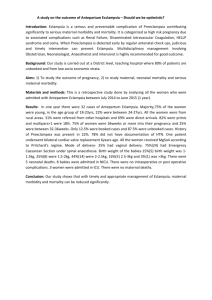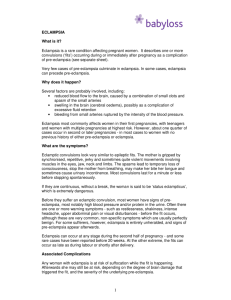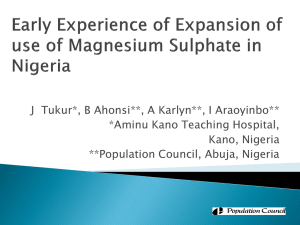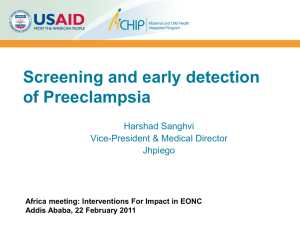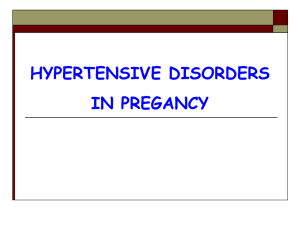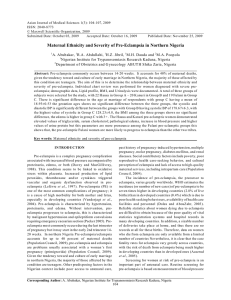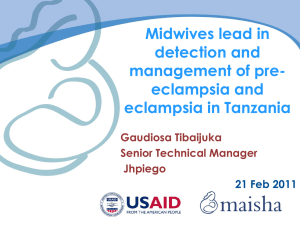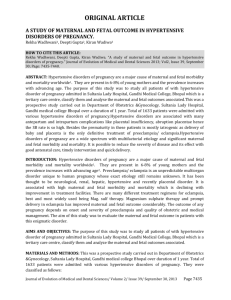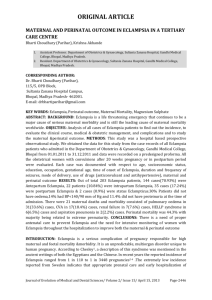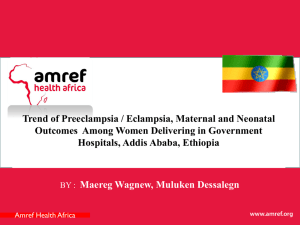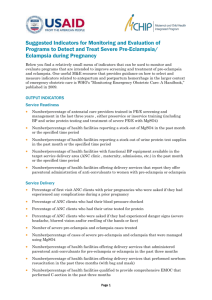Review of the Hypertensive Disorders on Pregnancy in
advertisement
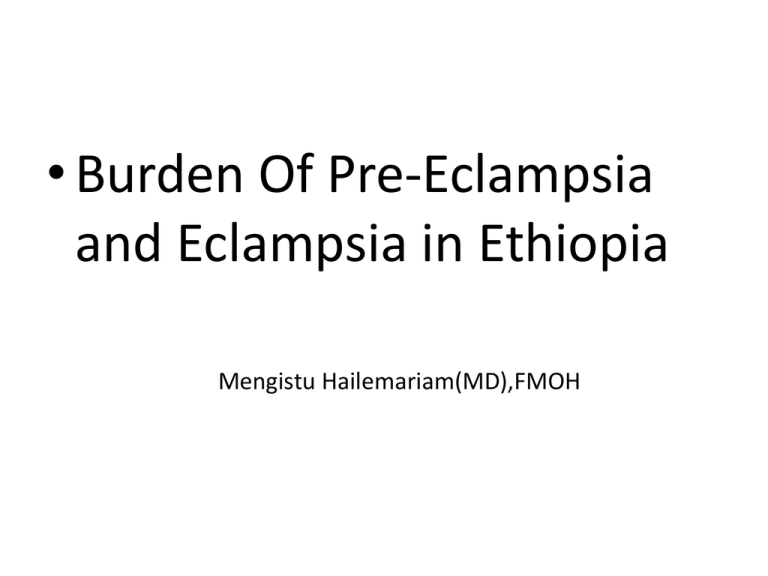
• Burden Of Pre-Eclampsia and Eclampsia in Ethiopia Mengistu Hailemariam(MD),FMOH Presentation Outline • • • • • Background information Maternal mortality in Ethiopia Causes of Maternal mortality Burden of Pre-eclampsia/Eclampsia Interventions Background Information, 2011 Ethiopia: Nine Administrative Regions -Two City Administration -817 woredas (districts) >15,000 Kebeles Tot. Pop., 79,221,000 Annual Expected Pregnancies≈3 million 3 Maternal mortality in Ethiopia Maternal Mortality Ratio MMR 1990 1068 (UN Estimate) MMR 2000 871 (EDHS 2000) MMR 2005 673 (EDHS 2005) MMR2008 470( WHO 2008) MDG target MMR 267 Causes of Maternal Death unsafe Abortion 13 % Other, 15% Sepsis, 15% Hypertension , 12% Hemorrriage 25 % Obstructed labor 20 % Burden of Preeclampsia/Eclampsia • Though hypertensive disorders of pregnancy are common in daily practice in our set up, there is no national study &there are only few studies in health institutions & there is a paucity of studies in the area. • A retrospective review of 6 articles on hypertensive disorders of pregnancy were identified from 1966 to 2007. Summary of the Studies No Author Title Years of Study Type of study 1 Jackson A Eclampsia in Addis Ababa: pattern & treatment (PTMH) 19661969 Retrospective survey 2 Getachew A Outcome of pregnancies complicated with preeclampsia-eclampsia disorders at SPH &TAH 1987 Case- control 3 Mekbib T Pre-eclampsia/eclampsia at Yekatit 12 Hospital, Addis Ababa, Ethiopia 19871989) Descriptive study 4 Abate M Eclampsia, a 5 year retrospective review of 216 cases managed in two teaching hospitals, AA(SPH &TAH) 1994-99 Descriptive study 5 Teklu S Prevalence & clinical correlates of hypertensive disorders of pregnancy at TAH 2003-04 Descriptive study 6 Kebede B Maternal & perinatal outcome of severe preeclampsia at the three teaching hospitals, 2007 Descriptive study Distribution of cases by age Age 1 2 3 4 5 6 Total 15-19 10 13 91 69 12 18 213 20-24 11 42 86 56 47 49 291 25-29 11 41 77 58 68 72 327(29. 38%) 30-34 2 28 51 20 31 35 167 >=35 1 14 43 13 25 19 115 total 35 138 348 216 183 193 1113 Distribution of cases by diagnosis Studi Mild es Preeclampsia Severe Eclampsia Preeclamp sia 1 Chronic HPN/+superim position HELLP/par Total tial HELLP 35 35 2 66 43 5 3 52 275 21 348 216 216 4 5 34 6 Total 85 104 152 507(45.55 %) 37 24 138 27 183 41 48 193 314(28.21% 92 ) 48 1113 intervention TYPE OF STUDY 1 intervention Preterm delivery Elective induction Elective C/S 12(35%) 0(0%) 13(37.5%) 86(39.8%) 36(16.7%) 90(42%) 2 3 4 5 89(48.6%) 107(58.5%) 6 108(56%) Total 313(28.12%) 22(11.4%) 58(5.2%) 97(50.4%) 289(25.9%) Management of eclampsia TYPE OF STUDY ANTICONVULSANT 1 LYTIC COCTAIL (CPZ,Promethasin and pethidin) 2 DIAZEPAM 3 DIAZEPAM 4 DIAZEPAM 5 DIAZEPAM 6 DIAZEPAM CONTROL OF CONVULSION LYTIC COCTAIL+THIOPENT 37% 65.7% MAGNISIUM SO4(60.6%) 73% CASE FATALITY RATE STUDIES CFR HDP Preeclampsia mild Eclampsia severe 1 2 17% ----- -------- ---------- 3 20% 23.8% 4 13% 5 2.7% ------ 6 4.1% 2.6% 7 (3.2%) mothers died before delivery 8% PERINATAL MORTALITY Still births Early Neonatal deaths Total PN deaths PNMR 1 9 3 12 342/00 2 11 10 21 152/00 3 30 29 59 165/00 4 44 25 69 312.2/00 5 40 18 58 300/00 6 27 32 59 306/00 Total 161 117 278 Maternal morbidity studies Study population ARF Pulmonar Abr y oedema upti on DIC PPH 2.8 % 11.6% ICU Intracranial referral haemorrhag e 1 2 3 4 eclampsia 5.5% 6.9% 5 6 Severe 20.2% 17.6% preeclampsia 26.9 % 12.4 15% % 13% Interventions to address preeclampsia/Eclampsia -The nation has identified that PE/E is one of the major causes of maternal mortality and various endeavors are ongoing: 1.Capacity Buiding -The preservice trainings of all health care providers have been made to address the issue of PE/E adequately -Inservice trainings on the management of PE/E using the gold standard Mgso4 are being given for health care providers of both the public and private health facilities -National Obstetrics service guideline has been revised to include use of Mgso4. Interventions to address preeclampsia/Eclampsia 2. Logistics -All the necessary supplies and equipments are being availed to health facilities for management of PE/E 3. Supportive supervision Thank You
